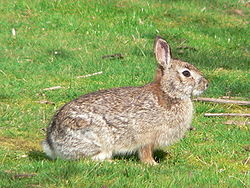Brush rabbit
| Brush rabbit | |
|---|---|
 |
|
| Brush rabbit (Finley National Wildlife Refuge) | |
| Scientific classification | |
| Kingdom: | Animalia |
| Phylum: | Chordata |
| Class: | Mammalia |
| Order: | Lagomorpha |
| Family: | Leporidae |
| Genus: | Sylvilagus |
| Species: | S. bachmani |
| Binomial name | |
|
Sylvilagus bachmani (Waterhouse, 1839) |
|
 |
|
| Brush rabbit range | |
The brush rabbit (Sylvilagus bachmani), or western brush rabbit, is a species of cottontail rabbit found in western coastal regions of North America, from the Columbia River in Oregon to the southern tip of the Baja California Peninsula. Its range extends as far east as the eastern sides of the Sierra Nevada and Cascade mountain ranges.
The brush rabbit inhabits dense, brushy cover, most commonly in chaparral vegetation. It also occurs in oak and conifer habitats and it will live in brush or grassland, and form networks of runways through the vegetation. The brush rabbit does not dig its own burrow or den, but uses the burrow of other species, brush piles, or forms. In the San Francisco Bay Area, it was found that the brush rabbit concentrates its activities at the edge of brush and exhibits much less use of grassy areas. It uses the interior brush of the wilderness and it was also found that this may be a better environment for it than the chaparral one. Studies done on the brush rabbit in Oregon also showed that it rarely left the brushy areas it inhabits. Brush may be used more in the drier seasons while grasses are used in the wetter seasons in relation to growth of annual vegetation. Use of habitat also probably is related to the breeding season.
The brush rabbit is smaller than many of the other cottontails, and unlike most of them, the underside of its tail is grey rather than white (which may be why its common name does not include the word "cottontail"). The upperside of the brush rabbit's fur varies from light brown to gray in color, while the underside is usually always white. Adult rabbits measure anywhere from 10–14 inches long and rarely weigh over two pounds.
...
Wikipedia

